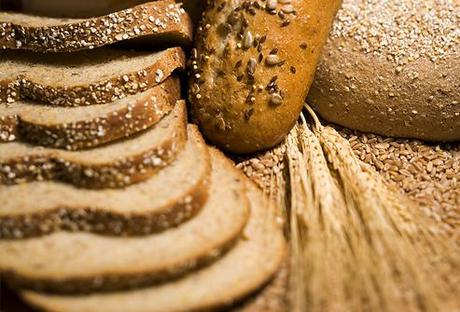 A blog post about grains, gluten, celiac disease, gluten sensitivity, wheat, etc. is long overdue here, and I admit that I’ve been procrastinating. Why? Every time I sit down to write about the topic, I get frustrated by all the misinformation floating around on the internet, in gyms, at health stores, and even in published diet books you can find at your local big-box bookstore in the health aisle. Because I’ve been enjoying a gluten-free and grain-free diet for years with great success, I forget how difficult it can be to sort through all the information out there to figure out what foods contain gluten, and whether all grains are “bad.” The reason for all the confusion about this topic? All I can say is that it’s a little bit like the game of “telephone” where you whisper something into the ear of the person next to you, and that person whispers what they heard to someone else, and so on until your message has gone through several people. When the message gets back to you, it has turned into something entirely different from what the original message started out as. It’s even easier for these kinds of misunderstandings to occur when information is spreading so fast via the internet (blogs, messageboards, emails, social media, podcasts, videos, etc.). I will try to be as clear and brief as possible here so I can allay some confusion and possibly help many of you discover the misunderstanding about gluten and grains that might be contributing to all your health and weight problems.
A blog post about grains, gluten, celiac disease, gluten sensitivity, wheat, etc. is long overdue here, and I admit that I’ve been procrastinating. Why? Every time I sit down to write about the topic, I get frustrated by all the misinformation floating around on the internet, in gyms, at health stores, and even in published diet books you can find at your local big-box bookstore in the health aisle. Because I’ve been enjoying a gluten-free and grain-free diet for years with great success, I forget how difficult it can be to sort through all the information out there to figure out what foods contain gluten, and whether all grains are “bad.” The reason for all the confusion about this topic? All I can say is that it’s a little bit like the game of “telephone” where you whisper something into the ear of the person next to you, and that person whispers what they heard to someone else, and so on until your message has gone through several people. When the message gets back to you, it has turned into something entirely different from what the original message started out as. It’s even easier for these kinds of misunderstandings to occur when information is spreading so fast via the internet (blogs, messageboards, emails, social media, podcasts, videos, etc.). I will try to be as clear and brief as possible here so I can allay some confusion and possibly help many of you discover the misunderstanding about gluten and grains that might be contributing to all your health and weight problems.
Myth #1: Celiac disease is a food allergy, digestive problem, or enzyme deficiency.
Truth: Celiac disease is an autoimmune disorder of the small intestine caused by an autoimmune reaction to gliadin, a component of the gluten protein found naturally in wheat, barley, spelt, kamut, and rye. Gluten is now also used to make a product called TVP or texturized vegetable protein, hydrolyzed vegetable protein, and seitan, which are commonly used to make vegetarian “faux meats.” Gluten may also be added to soups, boxed foods, ice creams, frozen dinners, and other processed food items to provide texture. Any foods containing wheat, barley, rye, triticale, spelt, kamut, malt or maltodextrin from an unspecified source, or flour (breakfast cereal, nutrition bars, waffles, chicken nuggets, burger buns, etc.) also contain gluten.
Myth #2: I don’t have digestive problems, so gluten must not be causing my arthritis, allergies, asthma, fibromyalgia, weight gain, mood swings, intense food cravings, headaches, PMS, [insert your ailment here]…
Truth: The most common symptoms of a gluten sensitivity or celiac disease are actually not digestive symptoms. The most common symptoms may be vague feelings of unwellness such as coughing or postnasal drip during and after meals, tiredness, insidious weight gain (particularly around the belly), brain “fog,”tiredness, skin rashes, fibromyalgia, and irritable bowel syndrome, or more obvious problems like infertility, thyroid problems, rheumatoid arthritis, lupus, Sjogren’s disease, Alzheimer’s disease, psychiatric disorders, and gallbladder disease. You can start having any of these symptoms at any age, meaning you can have no symptoms of a gluten intolerance when you’re 21, but by 41 you’ve got migraine headaches, early menopausal symptoms, and fibromyalgia that are all relieved by getting gluten (and grains) out of your diet.
Myth #3: My doctor tested me for celiac disease, but all my results came back normal. I don’t need to avoid gluten if I don’t have celiac disease.
It is estimated that at least 85% of people have some kind of undesirable symptom caused by eating gluten and grains. Celiac disease is one end of a spectrum in gluten sensitivity, meaning that it is diagnosable by intestinal biopsy, but most people fall somewhere in the middle of this spectrum. Blatant celiac disease may not be diagnosable by a simple blood test or intestinal biopsy in most people, but if they eliminate gluten and grains from their diet, it is likely that many of their health problems will be completely eliminated within a matter of a few months. Many patients have been able to get off all their medications even after years of being sick with chronic ailments. I am one example of such a patient. I completely eliminated chronic migraine headaches, threw away my inhaler for asthma, and no longer wake up in the mornings needing to sneeze and blow my nose. I have a lot more energy too, and many would probably say I look a lot healthier than I did 10 years ago when I was still eating grains and gluten. If my parents would have fed me bacon and eggs for breakfast when I was a child instead of oatmeal and low-fat “whole grain” cereal, I might not have developed many of the problems that I had to begin with. Thankfully, most of the damage has been reversible. (Whether I would have been taller and had a more attractive facial structure, we will never know for sure.)
Myth #4: Since other grains such as oats and rice are gluten-free, as long as I switch from eating wheat bread to eating gluten-free bread and gluten-free baking flours, I should be able to get rid of my belly fat, allergies, and chronic pain.
Truth: Cross-contamination of “gluten-free” grains with gluten-containing grains still remains an issue. Oats are often grown on land that was previously used for growing wheat, and they are commonly processed using the same equipment as wheat. Another problem with gluten-free breads, pastas, and flours is that they still have a high glycemic index that is often even higher than wheat bread. (Check the labels of many gluten-free breads and pastas, and you’ll find that the ones that don’t contain soy have almost no protein at all, and are even higher in calories and sugar than white bread.) And I certainly wouldn’t advocate switching from wheat to soy-based bread, pastas, and flours! High-glycemic “gluten-free” breads, pastas, cereals, cookies, cakes, pies, flours, and other things wreak havoc on your blood sugar, causing you to have food cravings and put on fat around your abdominal organs known as visceral fat. This visceral fat is not only viewed as unsightly by the fashion and fitness industries, it is also the #1 risk factor for heart disease, diabetes, chronic inflammation, and metabolic syndrome.

